Nursing Assignment: Rana Plaza Building Collapse Ethical Analysis
VerifiedAdded on 2020/02/23
|6
|1500
|30
Essay
AI Summary
This nursing assignment critically examines the ethical considerations surrounding clothing production, specifically in the context of the 2013 Rana Plaza factory collapse. The essay explores how this event challenges the common good both locally and globally, highlighting issues such as low wages, unsafe working conditions, and the exploitation of garment workers, particularly women. The assignment delves into the principles of Catholic Social Teaching (CST), emphasizing the dignity of the human person, the importance of the common good and community, the option for the poor, and the rights and responsibilities of workers. It proposes various solutions to address the challenges faced by garment workers, including increasing minimum wages, advocating for community engagement, empowering workers, and holding companies accountable. The essay underscores the need for ethical production practices, improved worker protections, and a commitment to social justice within the garment industry.
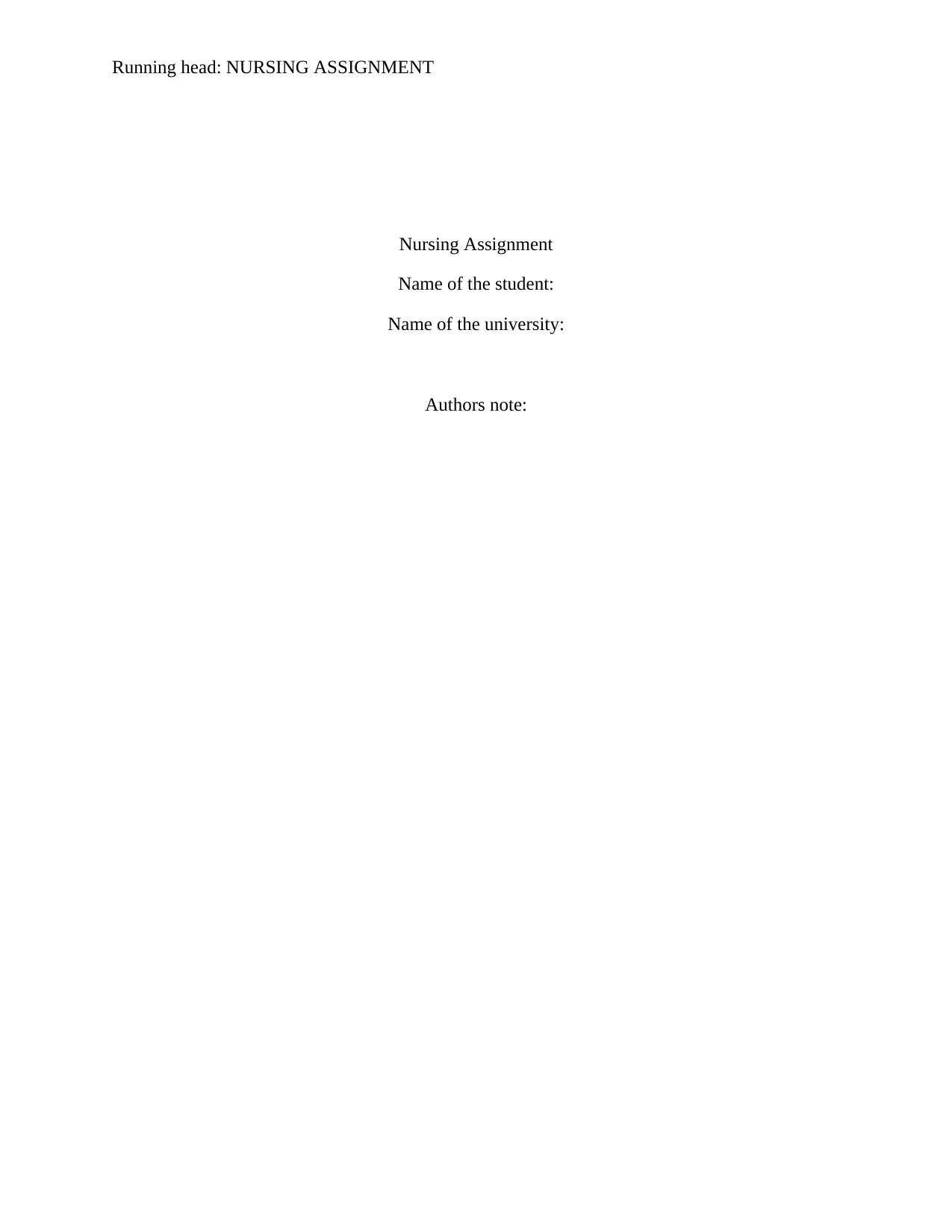
Running head: NURSING ASSIGNMENT
Nursing Assignment
Name of the student:
Name of the university:
Authors note:
Nursing Assignment
Name of the student:
Name of the university:
Authors note:
Paraphrase This Document
Need a fresh take? Get an instant paraphrase of this document with our AI Paraphraser
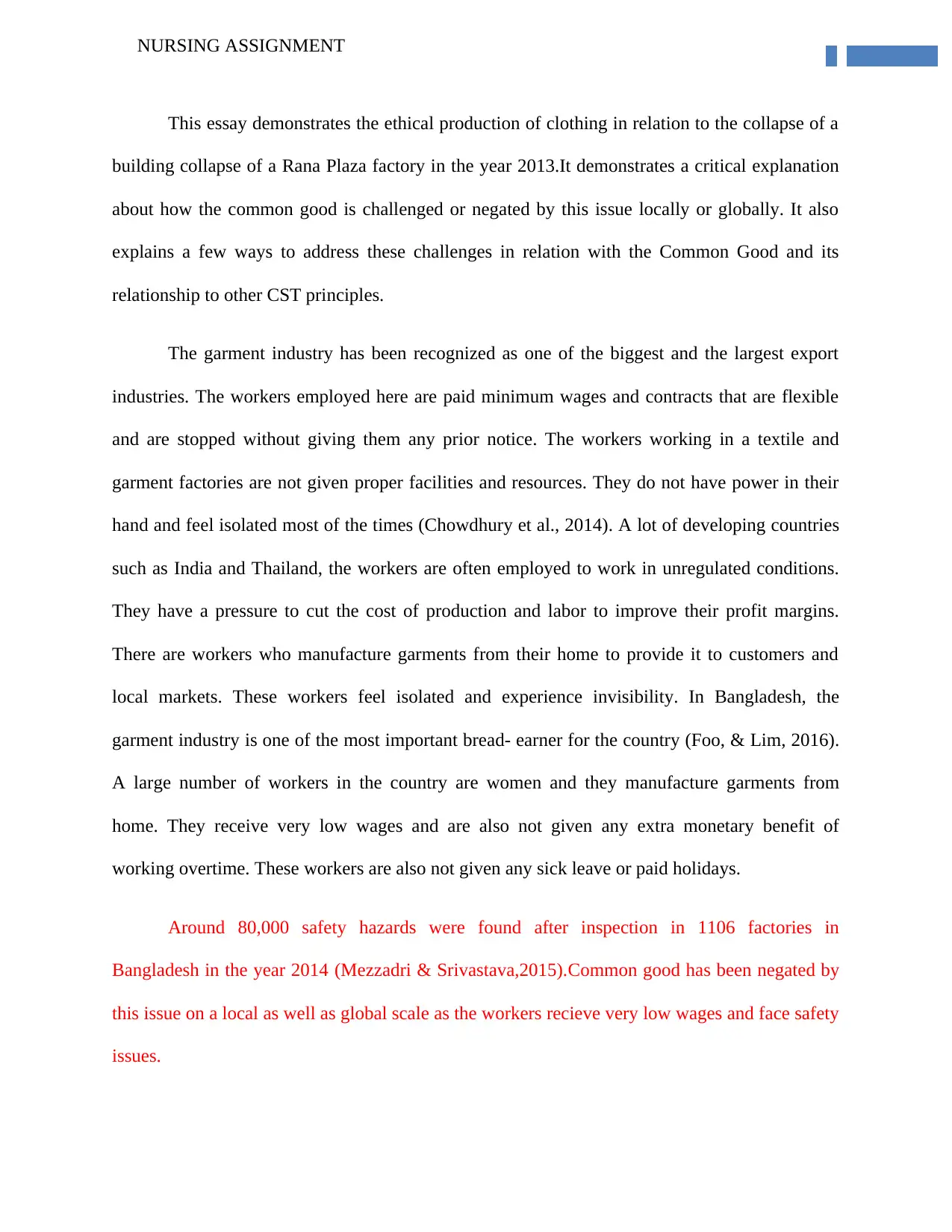
1
NURSING ASSIGNMENT
This essay demonstrates the ethical production of clothing in relation to the collapse of a
building collapse of a Rana Plaza factory in the year 2013.It demonstrates a critical explanation
about how the common good is challenged or negated by this issue locally or globally. It also
explains a few ways to address these challenges in relation with the Common Good and its
relationship to other CST principles.
The garment industry has been recognized as one of the biggest and the largest export
industries. The workers employed here are paid minimum wages and contracts that are flexible
and are stopped without giving them any prior notice. The workers working in a textile and
garment factories are not given proper facilities and resources. They do not have power in their
hand and feel isolated most of the times (Chowdhury et al., 2014). A lot of developing countries
such as India and Thailand, the workers are often employed to work in unregulated conditions.
They have a pressure to cut the cost of production and labor to improve their profit margins.
There are workers who manufacture garments from their home to provide it to customers and
local markets. These workers feel isolated and experience invisibility. In Bangladesh, the
garment industry is one of the most important bread- earner for the country (Foo, & Lim, 2016).
A large number of workers in the country are women and they manufacture garments from
home. They receive very low wages and are also not given any extra monetary benefit of
working overtime. These workers are also not given any sick leave or paid holidays.
Around 80,000 safety hazards were found after inspection in 1106 factories in
Bangladesh in the year 2014 (Mezzadri & Srivastava,2015).Common good has been negated by
this issue on a local as well as global scale as the workers recieve very low wages and face safety
issues.
NURSING ASSIGNMENT
This essay demonstrates the ethical production of clothing in relation to the collapse of a
building collapse of a Rana Plaza factory in the year 2013.It demonstrates a critical explanation
about how the common good is challenged or negated by this issue locally or globally. It also
explains a few ways to address these challenges in relation with the Common Good and its
relationship to other CST principles.
The garment industry has been recognized as one of the biggest and the largest export
industries. The workers employed here are paid minimum wages and contracts that are flexible
and are stopped without giving them any prior notice. The workers working in a textile and
garment factories are not given proper facilities and resources. They do not have power in their
hand and feel isolated most of the times (Chowdhury et al., 2014). A lot of developing countries
such as India and Thailand, the workers are often employed to work in unregulated conditions.
They have a pressure to cut the cost of production and labor to improve their profit margins.
There are workers who manufacture garments from their home to provide it to customers and
local markets. These workers feel isolated and experience invisibility. In Bangladesh, the
garment industry is one of the most important bread- earner for the country (Foo, & Lim, 2016).
A large number of workers in the country are women and they manufacture garments from
home. They receive very low wages and are also not given any extra monetary benefit of
working overtime. These workers are also not given any sick leave or paid holidays.
Around 80,000 safety hazards were found after inspection in 1106 factories in
Bangladesh in the year 2014 (Mezzadri & Srivastava,2015).Common good has been negated by
this issue on a local as well as global scale as the workers recieve very low wages and face safety
issues.
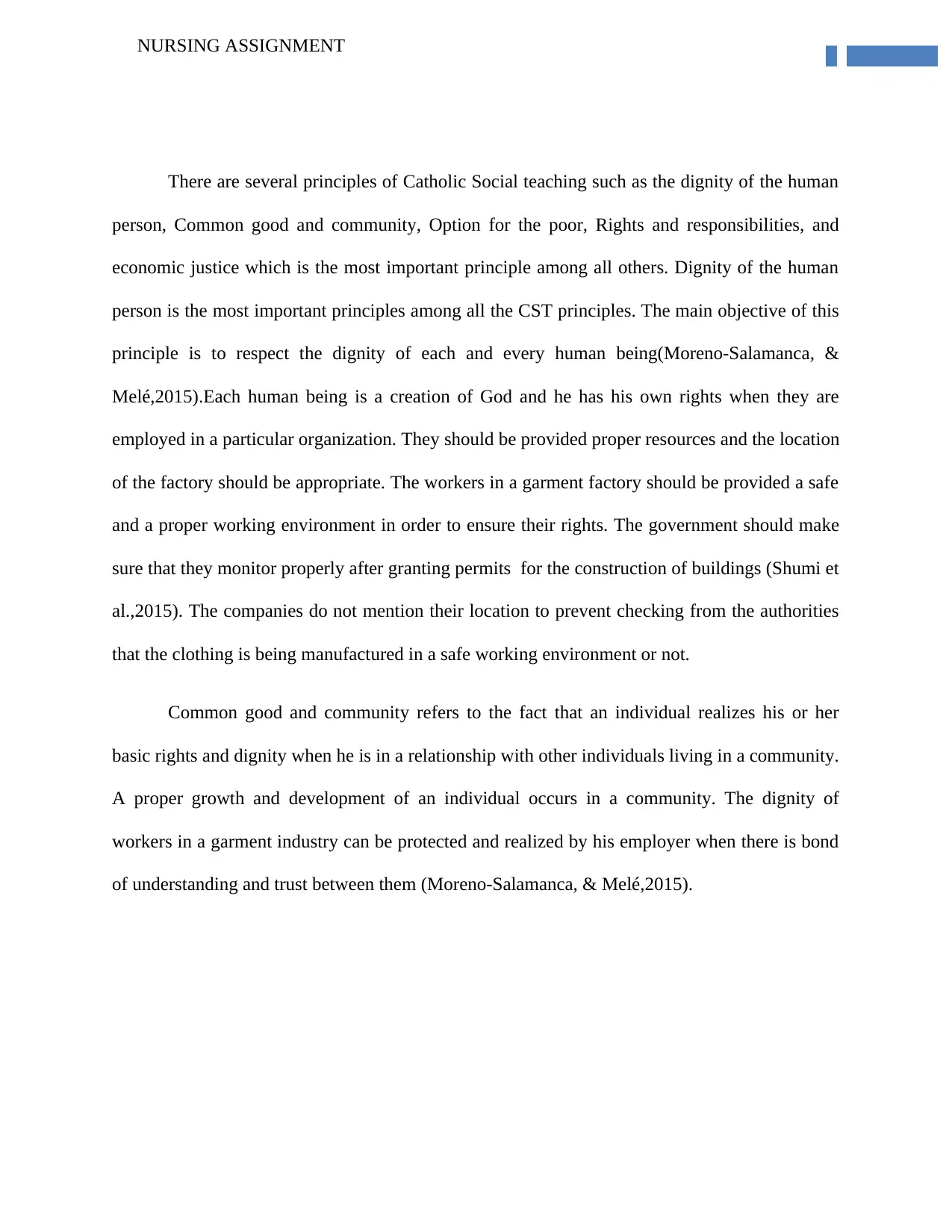
2
NURSING ASSIGNMENT
There are several principles of Catholic Social teaching such as the dignity of the human
person, Common good and community, Option for the poor, Rights and responsibilities, and
economic justice which is the most important principle among all others. Dignity of the human
person is the most important principles among all the CST principles. The main objective of this
principle is to respect the dignity of each and every human being(Moreno-Salamanca, &
Melé,2015).Each human being is a creation of God and he has his own rights when they are
employed in a particular organization. They should be provided proper resources and the location
of the factory should be appropriate. The workers in a garment factory should be provided a safe
and a proper working environment in order to ensure their rights. The government should make
sure that they monitor properly after granting permits for the construction of buildings (Shumi et
al.,2015). The companies do not mention their location to prevent checking from the authorities
that the clothing is being manufactured in a safe working environment or not.
Common good and community refers to the fact that an individual realizes his or her
basic rights and dignity when he is in a relationship with other individuals living in a community.
A proper growth and development of an individual occurs in a community. The dignity of
workers in a garment industry can be protected and realized by his employer when there is bond
of understanding and trust between them (Moreno-Salamanca, & Melé,2015).
NURSING ASSIGNMENT
There are several principles of Catholic Social teaching such as the dignity of the human
person, Common good and community, Option for the poor, Rights and responsibilities, and
economic justice which is the most important principle among all others. Dignity of the human
person is the most important principles among all the CST principles. The main objective of this
principle is to respect the dignity of each and every human being(Moreno-Salamanca, &
Melé,2015).Each human being is a creation of God and he has his own rights when they are
employed in a particular organization. They should be provided proper resources and the location
of the factory should be appropriate. The workers in a garment factory should be provided a safe
and a proper working environment in order to ensure their rights. The government should make
sure that they monitor properly after granting permits for the construction of buildings (Shumi et
al.,2015). The companies do not mention their location to prevent checking from the authorities
that the clothing is being manufactured in a safe working environment or not.
Common good and community refers to the fact that an individual realizes his or her
basic rights and dignity when he is in a relationship with other individuals living in a community.
A proper growth and development of an individual occurs in a community. The dignity of
workers in a garment industry can be protected and realized by his employer when there is bond
of understanding and trust between them (Moreno-Salamanca, & Melé,2015).
⊘ This is a preview!⊘
Do you want full access?
Subscribe today to unlock all pages.

Trusted by 1+ million students worldwide
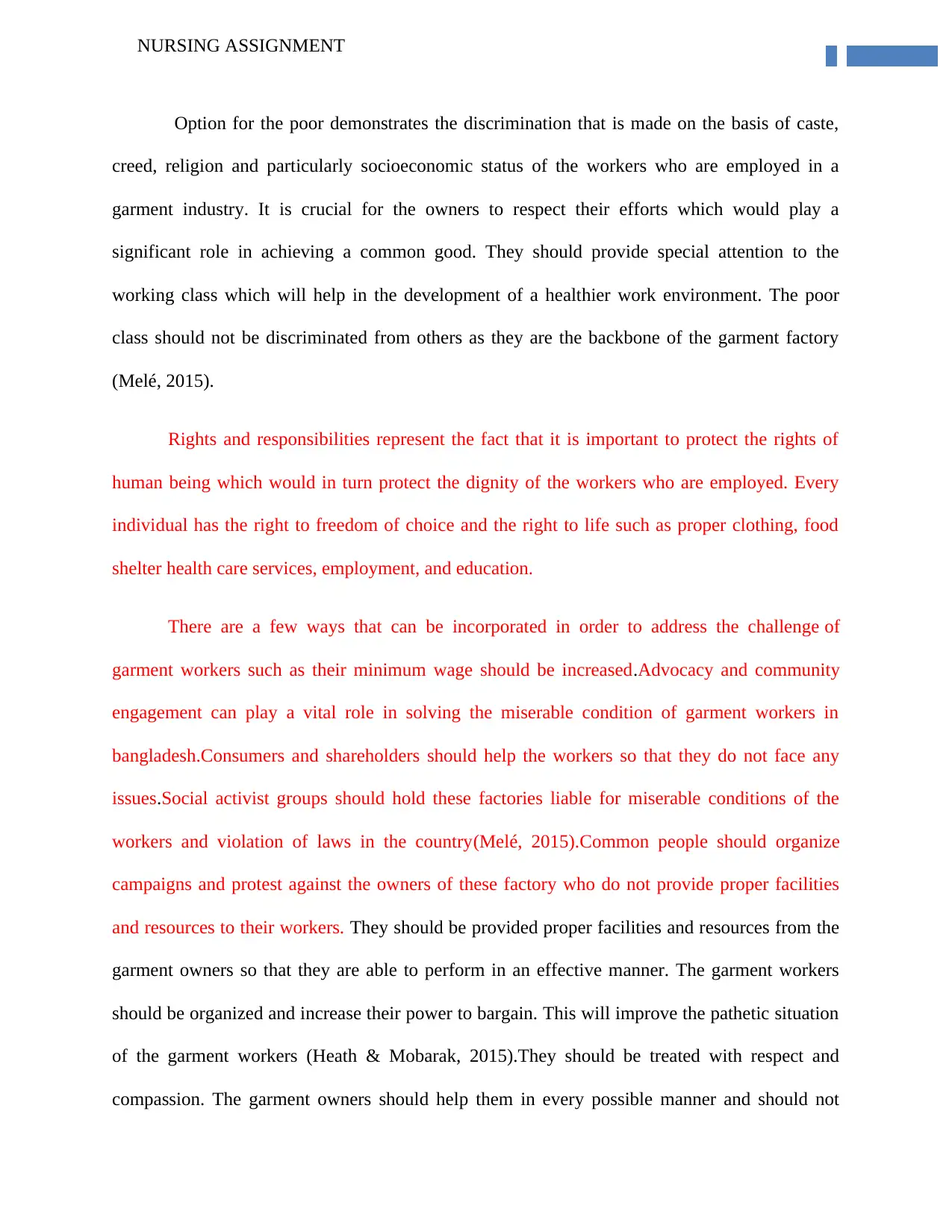
3
NURSING ASSIGNMENT
Option for the poor demonstrates the discrimination that is made on the basis of caste,
creed, religion and particularly socioeconomic status of the workers who are employed in a
garment industry. It is crucial for the owners to respect their efforts which would play a
significant role in achieving a common good. They should provide special attention to the
working class which will help in the development of a healthier work environment. The poor
class should not be discriminated from others as they are the backbone of the garment factory
(Melé, 2015).
Rights and responsibilities represent the fact that it is important to protect the rights of
human being which would in turn protect the dignity of the workers who are employed. Every
individual has the right to freedom of choice and the right to life such as proper clothing, food
shelter health care services, employment, and education.
There are a few ways that can be incorporated in order to address the challenge of
garment workers such as their minimum wage should be increased.Advocacy and community
engagement can play a vital role in solving the miserable condition of garment workers in
bangladesh.Consumers and shareholders should help the workers so that they do not face any
issues.Social activist groups should hold these factories liable for miserable conditions of the
workers and violation of laws in the country(Melé, 2015).Common people should organize
campaigns and protest against the owners of these factory who do not provide proper facilities
and resources to their workers. They should be provided proper facilities and resources from the
garment owners so that they are able to perform in an effective manner. The garment workers
should be organized and increase their power to bargain. This will improve the pathetic situation
of the garment workers (Heath & Mobarak, 2015).They should be treated with respect and
compassion. The garment owners should help them in every possible manner and should not
NURSING ASSIGNMENT
Option for the poor demonstrates the discrimination that is made on the basis of caste,
creed, religion and particularly socioeconomic status of the workers who are employed in a
garment industry. It is crucial for the owners to respect their efforts which would play a
significant role in achieving a common good. They should provide special attention to the
working class which will help in the development of a healthier work environment. The poor
class should not be discriminated from others as they are the backbone of the garment factory
(Melé, 2015).
Rights and responsibilities represent the fact that it is important to protect the rights of
human being which would in turn protect the dignity of the workers who are employed. Every
individual has the right to freedom of choice and the right to life such as proper clothing, food
shelter health care services, employment, and education.
There are a few ways that can be incorporated in order to address the challenge of
garment workers such as their minimum wage should be increased.Advocacy and community
engagement can play a vital role in solving the miserable condition of garment workers in
bangladesh.Consumers and shareholders should help the workers so that they do not face any
issues.Social activist groups should hold these factories liable for miserable conditions of the
workers and violation of laws in the country(Melé, 2015).Common people should organize
campaigns and protest against the owners of these factory who do not provide proper facilities
and resources to their workers. They should be provided proper facilities and resources from the
garment owners so that they are able to perform in an effective manner. The garment workers
should be organized and increase their power to bargain. This will improve the pathetic situation
of the garment workers (Heath & Mobarak, 2015).They should be treated with respect and
compassion. The garment owners should help them in every possible manner and should not
Paraphrase This Document
Need a fresh take? Get an instant paraphrase of this document with our AI Paraphraser
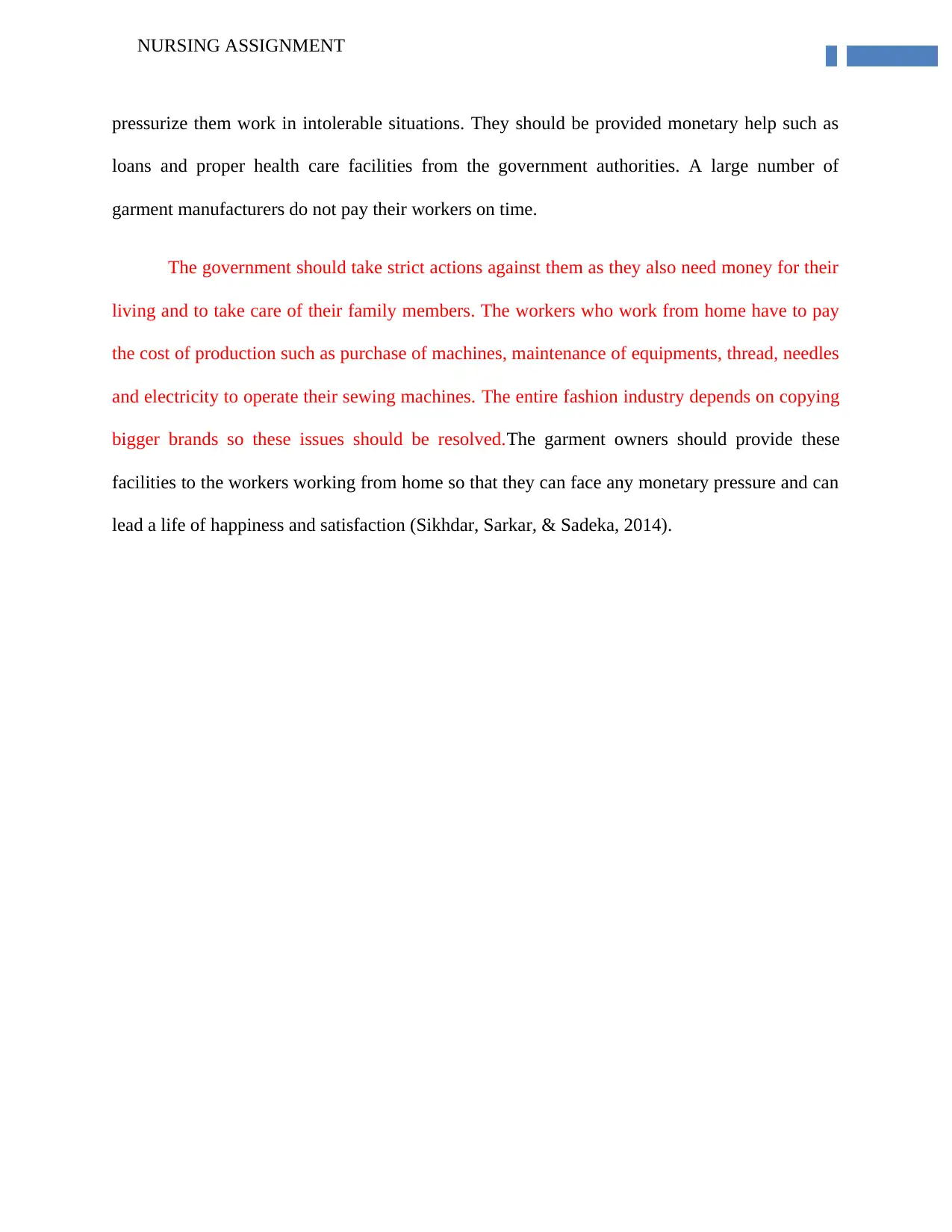
4
NURSING ASSIGNMENT
pressurize them work in intolerable situations. They should be provided monetary help such as
loans and proper health care facilities from the government authorities. A large number of
garment manufacturers do not pay their workers on time.
The government should take strict actions against them as they also need money for their
living and to take care of their family members. The workers who work from home have to pay
the cost of production such as purchase of machines, maintenance of equipments, thread, needles
and electricity to operate their sewing machines. The entire fashion industry depends on copying
bigger brands so these issues should be resolved.The garment owners should provide these
facilities to the workers working from home so that they can face any monetary pressure and can
lead a life of happiness and satisfaction (Sikhdar, Sarkar, & Sadeka, 2014).
NURSING ASSIGNMENT
pressurize them work in intolerable situations. They should be provided monetary help such as
loans and proper health care facilities from the government authorities. A large number of
garment manufacturers do not pay their workers on time.
The government should take strict actions against them as they also need money for their
living and to take care of their family members. The workers who work from home have to pay
the cost of production such as purchase of machines, maintenance of equipments, thread, needles
and electricity to operate their sewing machines. The entire fashion industry depends on copying
bigger brands so these issues should be resolved.The garment owners should provide these
facilities to the workers working from home so that they can face any monetary pressure and can
lead a life of happiness and satisfaction (Sikhdar, Sarkar, & Sadeka, 2014).
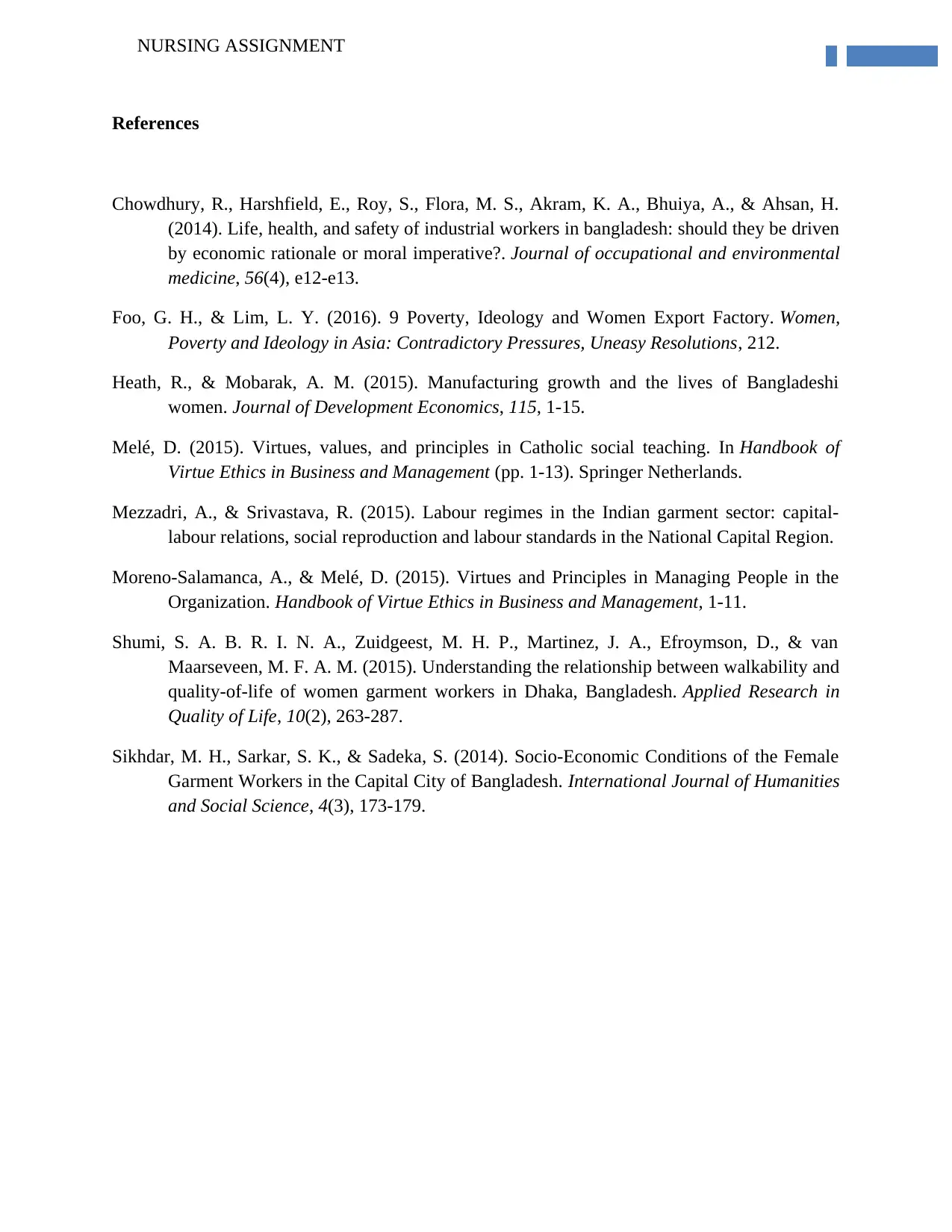
5
NURSING ASSIGNMENT
References
Chowdhury, R., Harshfield, E., Roy, S., Flora, M. S., Akram, K. A., Bhuiya, A., & Ahsan, H.
(2014). Life, health, and safety of industrial workers in bangladesh: should they be driven
by economic rationale or moral imperative?. Journal of occupational and environmental
medicine, 56(4), e12-e13.
Foo, G. H., & Lim, L. Y. (2016). 9 Poverty, Ideology and Women Export Factory. Women,
Poverty and Ideology in Asia: Contradictory Pressures, Uneasy Resolutions, 212.
Heath, R., & Mobarak, A. M. (2015). Manufacturing growth and the lives of Bangladeshi
women. Journal of Development Economics, 115, 1-15.
Melé, D. (2015). Virtues, values, and principles in Catholic social teaching. In Handbook of
Virtue Ethics in Business and Management (pp. 1-13). Springer Netherlands.
Mezzadri, A., & Srivastava, R. (2015). Labour regimes in the Indian garment sector: capital-
labour relations, social reproduction and labour standards in the National Capital Region.
Moreno-Salamanca, A., & Melé, D. (2015). Virtues and Principles in Managing People in the
Organization. Handbook of Virtue Ethics in Business and Management, 1-11.
Shumi, S. A. B. R. I. N. A., Zuidgeest, M. H. P., Martinez, J. A., Efroymson, D., & van
Maarseveen, M. F. A. M. (2015). Understanding the relationship between walkability and
quality-of-life of women garment workers in Dhaka, Bangladesh. Applied Research in
Quality of Life, 10(2), 263-287.
Sikhdar, M. H., Sarkar, S. K., & Sadeka, S. (2014). Socio-Economic Conditions of the Female
Garment Workers in the Capital City of Bangladesh. International Journal of Humanities
and Social Science, 4(3), 173-179.
NURSING ASSIGNMENT
References
Chowdhury, R., Harshfield, E., Roy, S., Flora, M. S., Akram, K. A., Bhuiya, A., & Ahsan, H.
(2014). Life, health, and safety of industrial workers in bangladesh: should they be driven
by economic rationale or moral imperative?. Journal of occupational and environmental
medicine, 56(4), e12-e13.
Foo, G. H., & Lim, L. Y. (2016). 9 Poverty, Ideology and Women Export Factory. Women,
Poverty and Ideology in Asia: Contradictory Pressures, Uneasy Resolutions, 212.
Heath, R., & Mobarak, A. M. (2015). Manufacturing growth and the lives of Bangladeshi
women. Journal of Development Economics, 115, 1-15.
Melé, D. (2015). Virtues, values, and principles in Catholic social teaching. In Handbook of
Virtue Ethics in Business and Management (pp. 1-13). Springer Netherlands.
Mezzadri, A., & Srivastava, R. (2015). Labour regimes in the Indian garment sector: capital-
labour relations, social reproduction and labour standards in the National Capital Region.
Moreno-Salamanca, A., & Melé, D. (2015). Virtues and Principles in Managing People in the
Organization. Handbook of Virtue Ethics in Business and Management, 1-11.
Shumi, S. A. B. R. I. N. A., Zuidgeest, M. H. P., Martinez, J. A., Efroymson, D., & van
Maarseveen, M. F. A. M. (2015). Understanding the relationship between walkability and
quality-of-life of women garment workers in Dhaka, Bangladesh. Applied Research in
Quality of Life, 10(2), 263-287.
Sikhdar, M. H., Sarkar, S. K., & Sadeka, S. (2014). Socio-Economic Conditions of the Female
Garment Workers in the Capital City of Bangladesh. International Journal of Humanities
and Social Science, 4(3), 173-179.
⊘ This is a preview!⊘
Do you want full access?
Subscribe today to unlock all pages.

Trusted by 1+ million students worldwide
1 out of 6
Related Documents
Your All-in-One AI-Powered Toolkit for Academic Success.
+13062052269
info@desklib.com
Available 24*7 on WhatsApp / Email
![[object Object]](/_next/static/media/star-bottom.7253800d.svg)
Unlock your academic potential
Copyright © 2020–2025 A2Z Services. All Rights Reserved. Developed and managed by ZUCOL.




